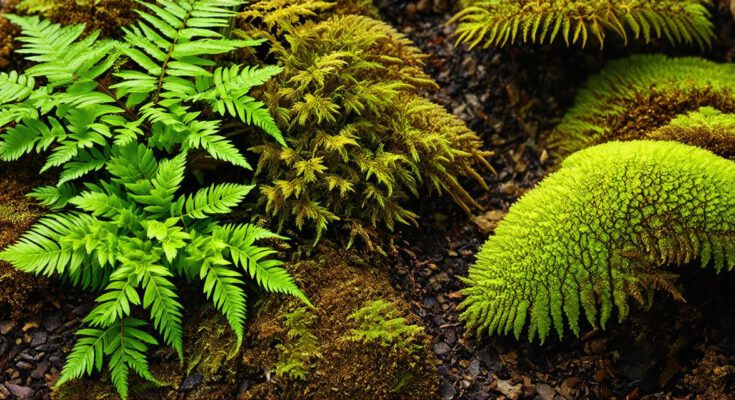Classification of Cryptogens
Cryptogens are traditionally classified as either mycoheterotrophic or mycorrhizal plants. Mycoheterotrophic plants form a mutualistic relationship with fungi, in which the plant provides sugars and other organic compounds to the fungus, while the fungus provides the plant with essential nutrients such as nitrogen, phosphorus, and potassium. In contrast, mycorrhizal plants form a symbiotic relationship with fungi that allows them to access nutrients in soil.
There are several types of cryptogens, including mosses, liverworts, hornworts, clubmosses, and ferns. Mosses and liverworts are classified as bryophytes, while hornworts and clubmosses are classified as vascular plants. Ferns are classified as pteridophytes.
Morphology of Cryptogens
Cryptogens have a variety of morphological features that set them apart from other plants. One key feature is their lack of specialized tissue for photosynthesis. Instead, they rely on chloroplasts that are found throughout the plant body, including in the leaves and stems. These chloroplasts are not as efficient at photosynthesis as those found in specialized tissues, but they provide enough energy to sustain the plant.
Another important morphological feature of cryptogens is their small size. Most cryptogens are less than 1 cm in diameter and have a relatively simple structure. This simplicity allows them to survive in harsh environments where other plants cannot. For example, mosses and liverworts are often found in damp, shady areas where light levels are low, while hornworts and clubmosses can be found in rocky, exposed areas with high levels of UV radiation.
Ecological Roles of Cryptogens
Cryptogens play important ecological roles in a variety of environments. One key role is their ability to colonize disturbed areas and help prevent soil erosion. They can also serve as hosts for a variety of fungi, which can break down organic matter and release nutrients back into the soil.
In addition to their ecological roles, cryptogens have important implications for human health. For example, many species of mosses and liverworts are rich in antioxidants and other compounds that have anti-inflammatory and anti-cancer properties. Some species of clubmosses and ferns are also used as food sources in some parts of the world, providing important nutrients such as iron and calcium.
Case Studies of Cryptogens
One example of a cryptogen that has received attention for its unique properties is the liverwort Asterella taurina. This liverwort is commonly known as “duckweed” due to its floating, duck-like appearance on the surface of water. Duckweed is not only able to photosynthesize efficiently under low light conditions, but it also contains high levels of antioxidants that have been shown to have anti-inflammatory and anti-cancer properties.
Another example of a cryptogen is the fern Osmunda taurica. This fern is commonly known as “shield fern” due to its large, shield-like leaves. Shield fern has been used as a food source in some parts of the world for centuries, providing important nutrients such as iron and calcium. In addition, the roots of shield fern are rich in compounds that have been shown to have anti-inflammatory properties.
FAQs
What are cryptogens?
Cryptogens are a group of plants that lack specialized tissue for photosynthesis. They rely on symbiotic relationships with other organisms, such as fungi, to obtain nutrients.
Are all plants classified as cryptogens?
No, not all plants are classified as cryptogens. Cryptogens are typically classified as either mycoheterotrophic or mycorrhizal plants, and there are several types of cryptogens, including mosses, liverworts, hornworts, clubmosses, and ferns.
What are the morphological features of cryptogens?
Cryptogens have a variety of morphological features that set them apart from other plants, including their lack of specialized tissue for photosynthesis, small size, and simple structure.
What are the ecological roles of cryptogens?
Cryptogens play important ecological roles in a variety of environments, including colonizing disturbed areas, helping prevent soil erosion, and serving as hosts for fungi that break down organic matter and release nutrients back into the soil.
What are some examples of cryptogen species?
Some examples of cryptogen species include Asterella taurina (duckweed), Osmunda taurica (shield fern), and Bryum alveolaris (common moss).
What are the health benefits of cryptogens?
Cryptogens have important implications for human health, including their ability to provide antioxidants and other compounds that have anti-inflammatory and anti-cancer properties. Some species of cryptogens are also used as food sources in some parts of the world, providing important nutrients such as iron and calcium.
Conclusion
Cryptogens are a unique and important group of plants that offer valuable insights into the evolution of plants and their interactions with other life forms. By understanding their classification, morphology, and ecological roles, we can gain a deeper appreciation for these fascinating organisms and their contributions to the natural world.



